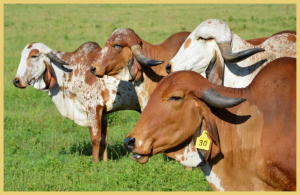GYR
The Gyr (or Gir) is one of the principal Zebu breeds originating in India. It has played a significant role in improving other cattle breeds, including the Red Sindhi and Sahiwal. Additionally, the Gyr was one of the foundation breeds used in developing the American Brahman in the United States.

Highly valued in Brazil and other South American countries, the Gyr thrives in hot climates due to its Bos indicus heritage, which grants it exceptional resistance to high temperatures and tropical diseases. The breed is also well known for its milk production, making it a key component in crossbreeding programs, particularly with Holstein-Friesian cows to create the Girolando breed—renowned for its high milk yield and adaptability to tropical environments.
Distinctive Characteristics
The Gyr is easily recognizable due to its unique physical traits:
- A rounded, domed forehead, making it the only ultra-convex cattle breed in the world.
- Long, pendulous ears that help with heat dissipation.
- Spiral-shaped horns that curve outward and backward.
- A mottled coat with colors ranging from red to yellow and white, though black is the only unacceptable color. Regardless of external coloration, the undercoat is always red, even in individuals that appear nearly white.
Originating in southwest India, particularly in the state of Gujarat, the breed has spread to Maharashtra and Rajasthan. Depending on the region where they were developed, Gyr cattle can vary in size—those from the Gyr Valley tend to be medium-sized, while those from surrounding mountainous areas are generally larger.
Adaptability and Unique Features
The Gyr possesses several natural adaptations that make it highly resilient:
- Oily skin secretion: Acts as a natural insect repellent, helping the breed withstand harsh tropical conditions.
- Extra subcutaneous muscle layer: Like horses, Zebu cattle have an additional layer of muscle just beneath their skin, allowing them to shake off flies and other parasites.
Historically, Gyr cattle were maintained by the Maldhari people, who depended on them for their livelihood. The breed is admired for its distinctive appearance, size, strength, and natural beauty.
Conservation Status
Despite its historical significance, the Gyr breed faces challenges in its native India. The increased preference for buffalo milk over cow’s milk has led to a decline in its population, putting the breed at risk of extinction in its homeland. However, conservation efforts in Brazil, South America, and other countries have ensured that the Gyr continues to thrive globally, particularly in dairy and crossbreeding programs.
1
2
3
4
5
6
Copyright © 2025 Bos Indicus International
Contact
P.O. Box 118
Butler, MO 64730
Email: office@bosindicusinternational.org
Phone: 816-738-4179







